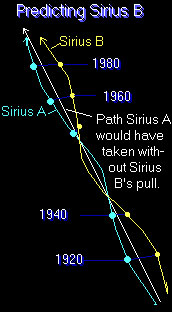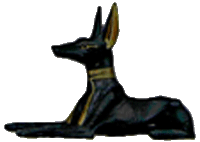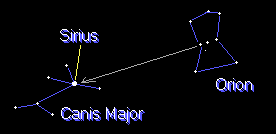|

Sirius is the largest and
most brilliant star in the heavens. It situated in the mouth of
the greater dog Canis Major, therefore it is known
as the 'Dog Star'. It is located in the
constellation
Canis Major and is 8.6 light years from Earth.
Sirius
is visible in the Northern hemisphere evening sky from November
through April.
|
Sirius is
over 20 times brighter than our Sun and over twice as massive.
Sirius is not the closest star system - the Alpha
Centauri system holds this distinction.
Sirius appears blue-white in color. It is the brightest
star in our sky after the Sun, and can easily be seen in the winter
months in the northern hemisphere. When looking at the constellation
Orion - locate
Orion's belt which are the three bright stars in a row. |
|
Follow an imaginary line through these stars to Sirius
which is just above the horizon.
|
 |
 |
|
Belt of Orion and the
Great Pyramid
|
Sirius - Queens Chamber
[Feminine] - The Pleiades [Sister Stars]
Orion - Kings Chamber - Thuban
[Thuban - Gold - Snake - Alpha Draconis - Reptilians
It was the pole star when the pyramids were built -
Seamen called it The Dragon's Tail] |
Sirius B
From 1834 to 1844 some irregularities were noticed in the movement of
Sirius by F.W. Bessel. It was supposed that
Sirius must be affected by a second star, and in 1862 a
faint companion star was finally detected by Alvan Clark, and
it was named Sirius B.
In 1920 the first spectrum of Sirius B was obtained by
W.Adams at Mount. Wilson, which is all that would have
been needed to classify it as a 'white dwarf star' - very small, yet
very massive. White dwarfs are small dense stars that burn dimly.
Sirius B although small and faint and about 10,000 times
dimmer than Sirius A is extremely dense and heavy
enough to exert influence on Sirius A. The pull of its
gravity caused Sirius' wavy movement.
Sirius B was the first white dwarf star discovered, a
type of star first understood by Subrahmanyan Chandrasekhar
in 1930. In 1970 the first photograph was taken of Sirius B
by Dr. Irving W. Lendenblad of the US Naval Observatory.
|
Sirius B is
invisible to the naked eye but packs almost the entire mass of our
sun into a globe only 4 times as large as the Earth. Sirius B's
surface is 300 times harder than diamonds, while its interior has a
density 3,000 times that of diamonds. Spinning on its axis about 23
times a minute, it generates huge magnetic fields around it.
The two stars,
Sirius A and Sirius B
move around each other, constantly exchanging particles.
Because of its greater density and magnetic field, Sirius B
takes the lion's share, taking gases and materials off of its larger
host body.
Sirius B has a super-heavy gravitationally powerful star
made of concentrated super-dense matter (essence) with the number 50
associated with it (describing its orbital period).
Every 49.9 years, Sirius A and B, come as close together
as their orbits allow, creating huge magnetic storms between them.
As they approach each other, the stars both begin to spin faster as
tidal forces become stronger, finally flip-flopping over, actually
trading places with each other. This energy is eventually released
to flow on magnetic field lines to the Sun, which transmits it like
a lens to all the planets. |

DNA Effect |

The Dogons
are a West African tribe who have known about - and worshipped -
Sirius A and its Twin the invisible star
Sirius B, for the past 5,000 years. They are have also been
aware of the planets circle the sun in elliptical orbits, the four
moons of Jupiter and the rings of Saturn.
They say that approximately 5,000 years ago, Amphibious Gods
came to Earth in three legged space ships from the Sirius
Star System.
They call the aliens Nommos.
In their religious dogma, they acknowledge that Sirius B
is immensely heavy, invisible, very small, yet extremely powerful.
Their understanding of the two stars' orbits coincides exactly with
modern astronomical findings, yet was arrived at thousands of years
before the equipment needed for such measurements even existed.
They also claim that a third star Emme Ya -
Sorghum Female - exists in the Sirius system. Larger and lighter
than Sirius B, this star revolves around Sirius
A as well.
Could there be a Sirius C?.
In 1995 two French researchers, Daniel Benest and J.L.
Duvent,
authored an article in the prestigious journal Astronomy and
Astrophysics with the title Is Sirius a Triple Star? and
suggested (based on observations of motions in the Sirius system)
there is a small third star there. They thought the star was
probably of a type known as a "brown dwarf" and only had about .05
the mass of Sirius B.

In Ancient Egypt Sirius was the brightest, and most
important star in the night sky. Sirius was astronomically the
foundation of their entire religious system. It was the embodiment
of Isis, sister and consort of the god
Osiris, who appeared in the sky as Orion.
Sirius' helical rising (when Sirius again rose into
visibility after being hidden by the Sun's light for 70 days) marked
the beginning of the Egyptian year and roughly coincided with the
flooding of the Nile, major events marked by feasting and
celebration. Egyptians believed
Sirius was responsible for the rains, so it was vital to
accurately predict its arrival. It was the centerpiece of Egypt's
365-day solar calendar, and its appearance marked the beginning of
the new year.
In the Sumerian civilization, predating the Egyptians, their epic poem
Epic of Gilgamesh describes a dream of Gilgamesh where
the hero is drawn irresistibly to a heavy star that cannot be lifted
despite immense effort. This star descends from heaven to him and is
described as having a very potent essence and being "the God of
heaven".
Gilgamesh had for his companions, 50 oarsmen in the
great ship, Argo, a constellation bordering Canis Major,
where Sirius is found.
|
Ancient Egyptians
called Sirius the 'Dog Star', after their god
Anubis,
whose head in pictograms resembled that of a doglike animal (a
jackal). In Egypt,
Sirius
shines for most of the summer, and since it is such a bright star, the
Egyptians actually believed that the additional light from this
nearby star was responsible for the summer heat. This of course is
not true. However the origin of the phrase 'the dog days of summer'
comes from this ancient belief - the 'dog star' being the root of
this common saying! |
 |
The Hopi
name for the star
Sirius is Blue Star Kachina.
The Greeks named the star, Sirius, which meant,
'scorching or burning'.

Sirius is linked to the color BLUE. It is
a blue-white star. Beings from Sirius were supposedly
BLUE tinged. There is a relationship to royalty called
'BLUEbloods' as they are supposedly descending from a BLUE alien
race.
Electricity...which is still part of the EM spectrum...when isolated
(not lightning) is BLUE in color. BLUE
is the frequency upon which we will move out of this experience.
There are many references to the color BLUE in prophecies.
-
Creational myths end with
something blue-white in the sky - light.
-
An ancient Hopi Indian
prophecy states, "When the Blue Star Kachina makes its
appearance in the heavens, the Fifth World will emerge".
-
The Hopi name for the star
Sirius is Blue Star Kachina.
-
Hopi Prophecy speaks of
Twin Kachinas - white and blue.
-
Blue Star Maiden Crystal
Skull
-
Indigo Children
-
El Morya, Master of The
Blue Ray
-
If the Dogons
are correct, The
Nommo Gods are 'Aquatic': BLUE Water
-
Why is Krishna
colored blue? "One of the theories is that Vishnu [God] is
blue because his association with water, is depicted blue; therefore
all his incarnations including Krishna, are shown as such."
|




